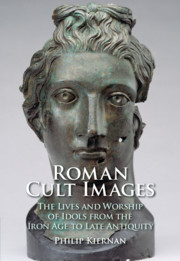Book contents
Three - The Birth of Cult Images
Continuity and Innovation in the Imperial Period
Published online by Cambridge University Press: 15 May 2020
Summary
The realization that cult images existed in the Iron Age has profound implications for our understanding of Romano-Celtic art. These earlier images likely served as the basis for later provincial representations of native divinities, which are not, as often proposed, later imperial period inventions. This chapter opens with an exploration of the continued use of Iron Age idols in the Roman period. Wooden images probably served as the main vehicle of transmission of iconography from the Iron Age and first century AD to the more abundant Roman stone representations of native divinities of the second and third centuries AD. The chapter considers monuments that contain purely native or combined native and Roman iconography, including depictions of Cernunnos, the mother goddesses, and Jupiter columns, before turning to the varied style and distribution of images of the gods with conventional Roman iconography. A final section examines how Mithraic cult images differed in form from earlier more static representations of the gods. We should envisage cult images as being continuously born throughout the Iron Age and Roman imperial period, existing side-by-side and in competition with older and newer images, with iconography following current and local trends and demands.
Keywords
- Type
- Chapter
- Information
- Roman Cult ImagesThe Lives and Worship of Idols from the Iron Age to Late Antiquity, pp. 85 - 145Publisher: Cambridge University PressPrint publication year: 2020

